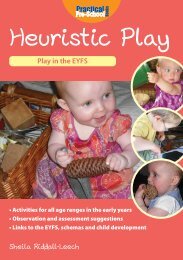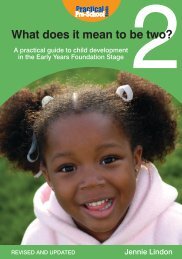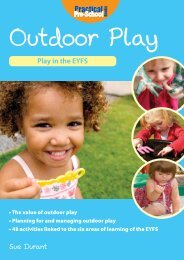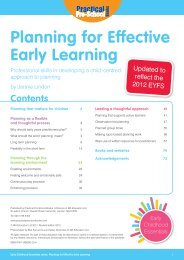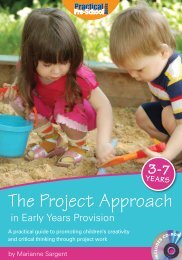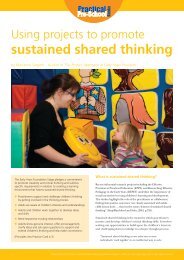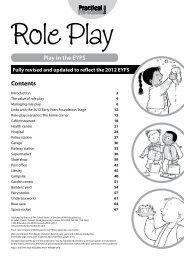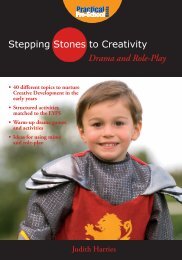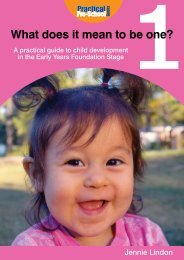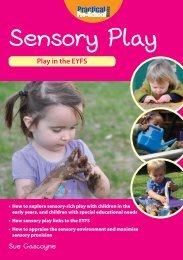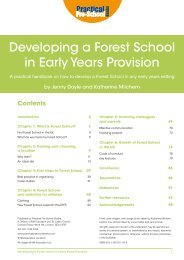Leadership and Management in the Early Years - Practical Pre ...
Leadership and Management in the Early Years - Practical Pre ...
Leadership and Management in the Early Years - Practical Pre ...
Create successful ePaper yourself
Turn your PDF publications into a flip-book with our unique Google optimized e-Paper software.
Books<strong>Leadership</strong> <strong>and</strong> <strong>Management</strong><strong>in</strong> <strong>the</strong> <strong>Early</strong> <strong>Years</strong>A practical guide to build<strong>in</strong>g confident leadership skillsby Jane CookContentsEffective leadership makes a difference 2Introduc<strong>in</strong>g <strong>the</strong> early years leader 4<strong>Leadership</strong> styles 5Characteristics, skills <strong>and</strong> roles 6The reflective leader 9Your own reflection 10Balance wheel 11Where are we go<strong>in</strong>g?The Importance of vision 18Practice examples 19Liv<strong>in</strong>g <strong>the</strong> vision 22An <strong>in</strong>troduction to supervision 35Practice examples 40Support <strong>and</strong> challenge 41Coach<strong>in</strong>g skills for supervision 43Listen<strong>in</strong>g 44Question<strong>in</strong>g 46Change <strong>and</strong> action plann<strong>in</strong>g 52Three lessons 55Prioritis<strong>in</strong>g 60Conclusion 64Build<strong>in</strong>g a team 27Motivation 30Delegation 32Books <strong>and</strong> websites 65Acknowledgements 66Published by <strong>Practical</strong> <strong>Pre</strong>-School Books, A Division of MA Education Ltd,St Jude’s Church, Dulwich Road, Herne Hill, London, SE24 0PB.Tel: 020 7738 5454www.practicalpreschoolbooks.com© MA Education Ltd 2013.Photos taken by Lucie Carlier. All photos © MA Education Ltd.All rights reserved. No part of this publication may be reproduced, stored <strong>in</strong> a retrieval system, or transmittedby any means, electronic, mechanical, photocopied or o<strong>the</strong>rwise, without <strong>the</strong> prior permission of <strong>the</strong> publisher.<strong>Early</strong>ChildhoodEssentialsISBN 978-1-907241-42-0<strong>Early</strong> Childhood Essentials series: <strong>Leadership</strong> <strong>and</strong> <strong>Management</strong> <strong>in</strong> <strong>the</strong> <strong>Early</strong> <strong>Years</strong> 1
IntroductionEffective leadershipmakes a difference“<strong>Leadership</strong> <strong>and</strong> learn<strong>in</strong>g are <strong>in</strong>dispensable to each o<strong>the</strong>r”John F. Kennedy.This book has been written for everyone with a leadership role,or th<strong>in</strong>k<strong>in</strong>g about a leadership role, with<strong>in</strong> <strong>the</strong> early years sector.It has been <strong>in</strong>spired by all <strong>the</strong> creative, passionate, clever,hard-work<strong>in</strong>g, funny <strong>and</strong> determ<strong>in</strong>ed leaders I have worked withdur<strong>in</strong>g <strong>the</strong> past thirty years.Work<strong>in</strong>g <strong>in</strong> <strong>the</strong> early years, we know that good qualityeducation <strong>and</strong> care makes a difference to children’s lives<strong>and</strong> that this cont<strong>in</strong>ues to have positive impact many yearsafter <strong>the</strong> child has left <strong>the</strong> sett<strong>in</strong>g. The role of <strong>the</strong> leader<strong>in</strong> creat<strong>in</strong>g <strong>the</strong> quality to make that difference, is crucial.All <strong>the</strong> research is tell<strong>in</strong>g us that <strong>the</strong> quality of provision<strong>and</strong> children’s outcomes almost never exceeds <strong>the</strong> quality ofleadership <strong>and</strong> management.“….<strong>the</strong>re is no doubt that effective leadership <strong>and</strong>appropriate tra<strong>in</strong><strong>in</strong>g for <strong>the</strong> leadership role is an <strong>in</strong>creas<strong>in</strong>glyimportant element <strong>in</strong> provid<strong>in</strong>g high quality provision for <strong>the</strong>early years” Siraj-Blatchford <strong>and</strong> Manni (2007).Why leadership <strong>in</strong><strong>the</strong> early years matters“We must be <strong>the</strong> change we wish to see <strong>in</strong> <strong>the</strong> world”Mahatma G<strong>and</strong>hi.Those of us work<strong>in</strong>g <strong>in</strong> early years have always known howimportant our work is. We know that a child is only a baby, atoddler, a young child once – <strong>and</strong> it’s vital that we make thatexperience <strong>the</strong> very best possible for every child. We alsoknow that early childhood is <strong>the</strong> foundation upon which allfuture development depends. We are rightly proud when ouryoung children move to a primary school confident <strong>and</strong> excitedabout <strong>the</strong>ir own abilities <strong>and</strong> feel<strong>in</strong>g secure about <strong>the</strong>ir place <strong>in</strong><strong>the</strong> world.The greater <strong>the</strong> change <strong>and</strong> uncerta<strong>in</strong>ty, <strong>the</strong> more important it isto hold on to your core values about early childhood education.These are expressed <strong>in</strong> <strong>the</strong> EYFS as:Theme: A Unique ChildPr<strong>in</strong>ciple: Every child is a competent learner from birth who canbe resilient, capable, confident <strong>and</strong> self-assured.Every child is a competent learner from birth, who canbe resilient, capable, confident <strong>and</strong> self-assuredTheme: Positive Relationships2<strong>Early</strong> Childhood Essentials series: <strong>Leadership</strong> <strong>and</strong> <strong>Management</strong> <strong>in</strong> <strong>the</strong> <strong>Early</strong> <strong>Years</strong>
Chapter 1Introduc<strong>in</strong>g <strong>the</strong>early years leader“Today a reader, tomorrow a leader”Margaret Fuller, 19th Century Women’s Rights Activist.identified ten categories of ‘effective leadership practice’(Institute of Education, 2007) as follows:Effective leadership practiceThis is an excit<strong>in</strong>g time to be work<strong>in</strong>g <strong>in</strong> early years, butit is also a challeng<strong>in</strong>g one for leaders <strong>and</strong> practitionersacross <strong>the</strong> sector. With more attention, comes <strong>in</strong>creasedexpectation <strong>and</strong> accountability. With more opportunity, comes<strong>in</strong>creased complexity <strong>and</strong> dem<strong>and</strong>s on time. In an implicitacknowledgement of <strong>the</strong> range <strong>and</strong> scope of <strong>the</strong> leadershiprole <strong>in</strong> <strong>the</strong> early years, Iram Siraj-Blatchford <strong>and</strong> Laura Manni1. Identify<strong>in</strong>g <strong>and</strong> articulat<strong>in</strong>g a collective vision2. Ensur<strong>in</strong>g shared underst<strong>and</strong><strong>in</strong>g, mean<strong>in</strong>gs <strong>and</strong> goals3. Effective communication4. Encourag<strong>in</strong>g reflection5. Monitor<strong>in</strong>g <strong>and</strong> assess<strong>in</strong>g practice6. Commitment to ongo<strong>in</strong>g, professional development7. Distributed leadership8. Build<strong>in</strong>g a learn<strong>in</strong>g community <strong>and</strong> team culture9. Encourag<strong>in</strong>g <strong>and</strong> facilitat<strong>in</strong>g parent<strong>and</strong> community partnerships10. Lead<strong>in</strong>g <strong>and</strong> manag<strong>in</strong>g: strik<strong>in</strong>g <strong>the</strong> balance.Observ<strong>in</strong>g children will have streng<strong>the</strong>nedour empathy <strong>and</strong> reflective skillsThis may look a daunt<strong>in</strong>g list, but <strong>the</strong> experience of anearly years practitioner provides an excellent foundationfor leadership. When practitioners move from work<strong>in</strong>g withchildren to lead<strong>in</strong>g adults, what is most often emphasised is<strong>the</strong> difference between <strong>the</strong> two roles. There are differences,which mean <strong>the</strong>re will be areas for learn<strong>in</strong>g <strong>and</strong> developmentto explore throughout this book. But <strong>the</strong>re are also hugesimilarities. From work<strong>in</strong>g with children <strong>and</strong> <strong>the</strong>ir families we willhave developed a huge range of useful communication skills.In plann<strong>in</strong>g an environment we will have built up organisational<strong>and</strong> plann<strong>in</strong>g skills. Observ<strong>in</strong>g children will have streng<strong>the</strong>nedour empathy <strong>and</strong> reflective skills. Above all, we will have carriedwith us a vision for quality that will cont<strong>in</strong>ue to develop <strong>and</strong><strong>in</strong>spire us throughout our professional lives.4<strong>Early</strong> Childhood Essentials series: <strong>Leadership</strong> <strong>and</strong> <strong>Management</strong> <strong>in</strong> <strong>the</strong> <strong>Early</strong> <strong>Years</strong>
The reflective leaderHow well do you know your strengths <strong>and</strong> weaknesses?The benefits of feedbackM<strong>in</strong>a, a new foundation stage coord<strong>in</strong>ator <strong>in</strong> a busy primaryschool. The previous coord<strong>in</strong>ator was conscientious, but<strong>the</strong> curriculum plann<strong>in</strong>g <strong>and</strong> environment had been gett<strong>in</strong>ga little tired.In M<strong>in</strong>a’s Open area are her enthusiasm, her energy <strong>and</strong> herpassion for mak<strong>in</strong>g a difference for <strong>the</strong> children. This hashelped her build up some positive relationships with<strong>in</strong> <strong>the</strong>team who see her commitment <strong>and</strong> respect her knowledge<strong>and</strong> expertise. In M<strong>in</strong>a’s Bl<strong>in</strong>d area is her tendency to talkover people <strong>in</strong> meet<strong>in</strong>gs as she gets carried away with herenthusiasm. Some of <strong>the</strong> team are beg<strong>in</strong>n<strong>in</strong>g to see thisas a lack of respect for <strong>the</strong>ir views – <strong>and</strong> <strong>the</strong>y are start<strong>in</strong>gto dig <strong>in</strong> <strong>the</strong>ir heels aga<strong>in</strong>st some of <strong>the</strong> changes. She alsotalks very fast about th<strong>in</strong>gs that she underst<strong>and</strong>s but canleave o<strong>the</strong>rs beh<strong>in</strong>d, feel<strong>in</strong>g nervous <strong>and</strong> unconfident about<strong>the</strong>ir ability to take forward <strong>the</strong> proposed changes. In M<strong>in</strong>a’sHidden area is her worry that if <strong>the</strong> school had an <strong>in</strong>spectionat <strong>the</strong> moment <strong>the</strong>y would have a very poor result. She’snot very confident about giv<strong>in</strong>g negative feedback <strong>and</strong>had hoped to move quickly with <strong>the</strong> developments withouthav<strong>in</strong>g to upset anyone by appear<strong>in</strong>g to be critical aboutwhat had been <strong>the</strong>re before. In M<strong>in</strong>a’s Unknown area isher unconscious assumption that be<strong>in</strong>g honest about herconcerns will turn everyone aga<strong>in</strong>st her.The result for M<strong>in</strong>a was that <strong>the</strong> she <strong>and</strong> <strong>the</strong> staffwere start<strong>in</strong>g to drift fur<strong>the</strong>r <strong>and</strong> fur<strong>the</strong>r apart. Theymisunderstood her communication style <strong>and</strong> didn’t tell her<strong>and</strong> so she thought that <strong>the</strong>y were just gang<strong>in</strong>g up aga<strong>in</strong>s<strong>the</strong>r <strong>and</strong> resistant to any change. What rescued <strong>the</strong> situationwas feedback. The headteacher had observed a staffmeet<strong>in</strong>g <strong>and</strong> fed back to M<strong>in</strong>a what she had seen – that<strong>the</strong> staff did not underst<strong>and</strong> her plans <strong>and</strong> that M<strong>in</strong>a wasn’tgiv<strong>in</strong>g <strong>the</strong>m enough time to contribute to <strong>the</strong> discussions.Toge<strong>the</strong>r, M<strong>in</strong>a <strong>and</strong> <strong>the</strong> headteacher planned <strong>the</strong> next staffmeet<strong>in</strong>g to ensure that everybody was <strong>in</strong>volved <strong>and</strong> hadtime to th<strong>in</strong>k <strong>and</strong> reflect about M<strong>in</strong>a’s suggestions – <strong>and</strong>make some of <strong>the</strong>ir own. The headteacher also encouragedM<strong>in</strong>a to be honest with <strong>the</strong> team about where she saw <strong>the</strong>quality of <strong>the</strong> sett<strong>in</strong>g at <strong>the</strong> moment – giv<strong>in</strong>g praise to whatwas go<strong>in</strong>g well, but expla<strong>in</strong><strong>in</strong>g why <strong>the</strong>y needed to makesome changes to better meet <strong>the</strong> requirements of <strong>the</strong> EYFS.14<strong>Early</strong> Childhood Essentials series: <strong>Leadership</strong> <strong>and</strong> <strong>Management</strong> <strong>in</strong> <strong>the</strong> <strong>Early</strong> <strong>Years</strong>
Coach<strong>in</strong>g skills for supervisionDescrib<strong>in</strong>g feedback tableFeedbackWhere possible, builds on a strengthLooks to <strong>the</strong> futureSolution-focusedAbout factsSays “<strong>and</strong>”Is two-wayCriticismAlways focuses on <strong>the</strong> negativeConcentrates on what happened <strong>in</strong> <strong>the</strong> pastLooks for someone to blameOften generalisesSays “but”Is one-wayLINKS WITH YOUR PRACTICEUs<strong>in</strong>g <strong>the</strong> feedback column as a guide, th<strong>in</strong>k about howyou could give feedback to <strong>the</strong>se practitioners <strong>in</strong> <strong>the</strong>follow<strong>in</strong>g scenarios.For example: Jane is an experienced member of staff witha particular way of putt<strong>in</strong>g up displays. They are neat <strong>and</strong>attractive. You’d like <strong>the</strong>m to be more <strong>in</strong>teractive <strong>and</strong> childcentred.What feedback are you go<strong>in</strong>g to give her?Feedback – Possible th<strong>in</strong>gs to sayHow could you help to change <strong>the</strong>ir behaviour <strong>and</strong> motivate<strong>the</strong>m to work towards achiev<strong>in</strong>g <strong>the</strong>ir full potential?• You’ve just taken over from an outst<strong>and</strong><strong>in</strong>g roomleader. Everyone is very confident <strong>and</strong> clear aboutwhat <strong>the</strong>y do <strong>and</strong> how, but you would like <strong>the</strong>m totune-<strong>in</strong> a bit more to <strong>the</strong> children’s play, have a bitmore reflection time for adults <strong>and</strong> children.Where possible, builds on a strength: Thank you for putt<strong>in</strong>g upthat new display <strong>in</strong> <strong>the</strong> entrance hall about <strong>the</strong> work we’ve beendo<strong>in</strong>g on children’s speak<strong>in</strong>g <strong>and</strong> listen<strong>in</strong>g. Your displays are alwaysbeautifully presented <strong>and</strong> show how you value <strong>the</strong> children’s work.Solution-focused: I’d like us to build on that to <strong>in</strong>clude moreideas from <strong>the</strong> children about how to display <strong>the</strong>ir work, perhapswith some captions us<strong>in</strong>g <strong>the</strong>ir own words.• Your strongest practitioner has asked for feedbackas she’s th<strong>in</strong>k<strong>in</strong>g about promotion. She’s veryproud of her observations <strong>and</strong> wants to start with<strong>the</strong>se. You’ve noticed that <strong>the</strong>y are long <strong>and</strong> notalways to <strong>the</strong> po<strong>in</strong>t…• Your new team member is regularly late. She alwayshas an excuse as she comes through <strong>the</strong> door…• Your weak student doesn’t seem to be mak<strong>in</strong>g muchprogress <strong>in</strong> her plann<strong>in</strong>g. She’s keen <strong>and</strong> will<strong>in</strong>g<strong>and</strong> has a sensitive way of talk<strong>in</strong>g to <strong>the</strong> childrenbut her file is almost empty <strong>and</strong> her ideas for focusexperiences for <strong>the</strong> children are usually ra<strong>the</strong>r dull(although she always says that she’s follow<strong>in</strong>g <strong>the</strong>children’s ideas).Looks to <strong>the</strong> future: So, when we do <strong>the</strong> next display can weget toge<strong>the</strong>r first <strong>and</strong> th<strong>in</strong>k of some more ideas about how thismight work?Po<strong>in</strong>t for reflectionTh<strong>in</strong>k of a time when you have received feedback that hasbeen motivat<strong>in</strong>g.Now th<strong>in</strong>k of a time when you have been given feedbackthat has demotivated you.What did <strong>the</strong> person giv<strong>in</strong>g <strong>the</strong> feedback say or do? Whatdid you feel? What did you say or do?50<strong>Early</strong> Childhood Essentials series: <strong>Leadership</strong> <strong>and</strong> <strong>Management</strong> <strong>in</strong> <strong>the</strong> <strong>Early</strong> <strong>Years</strong>



